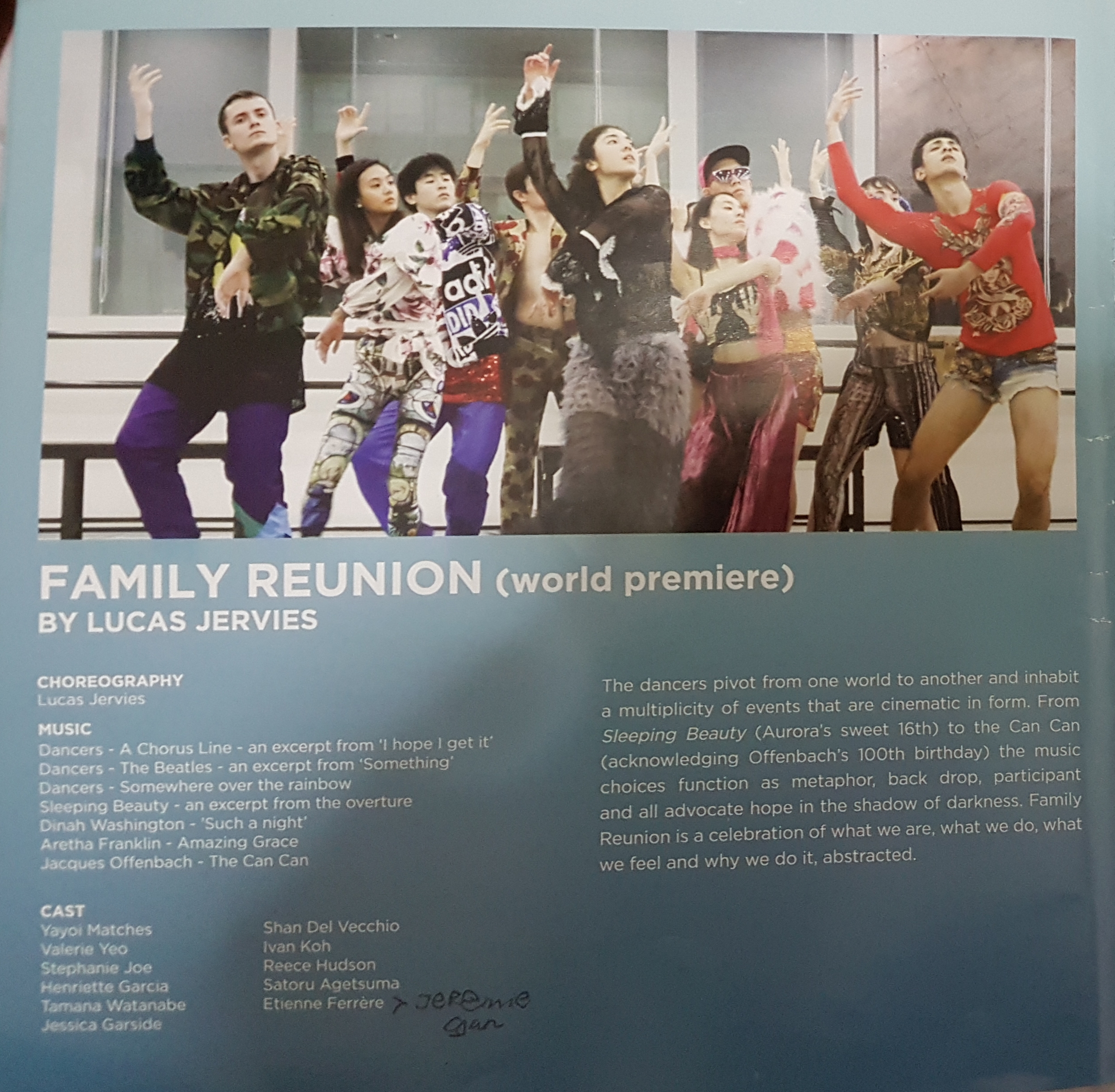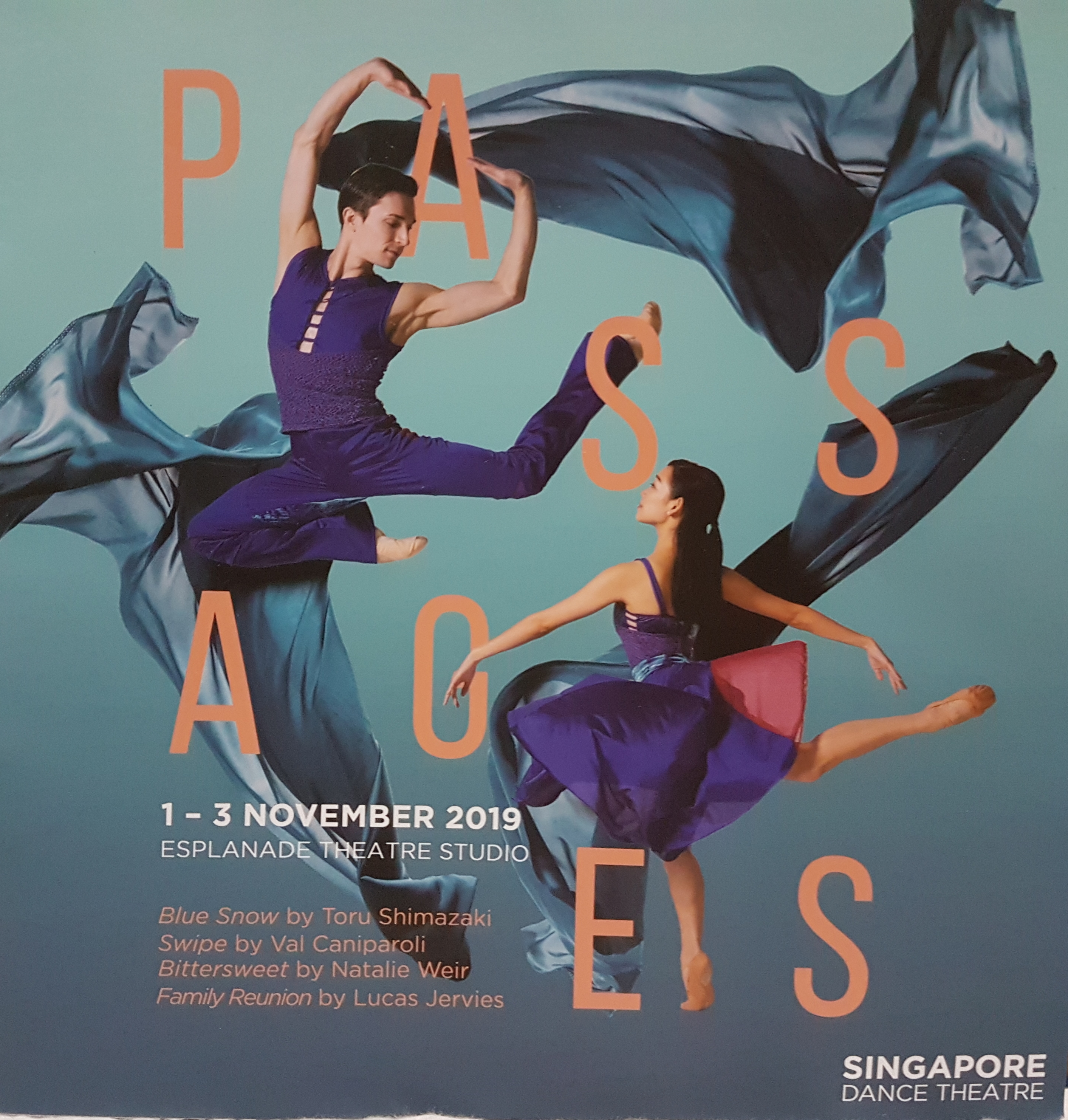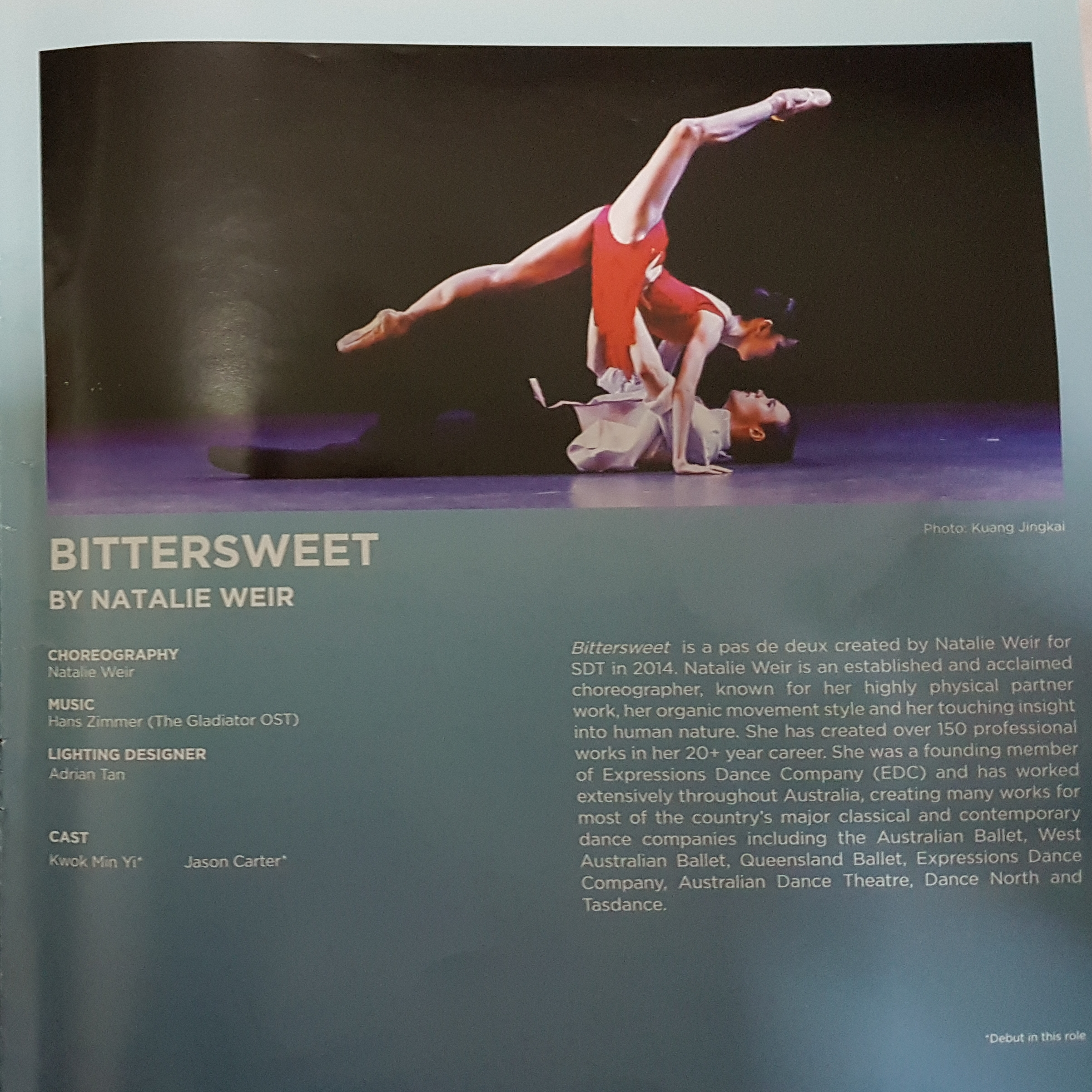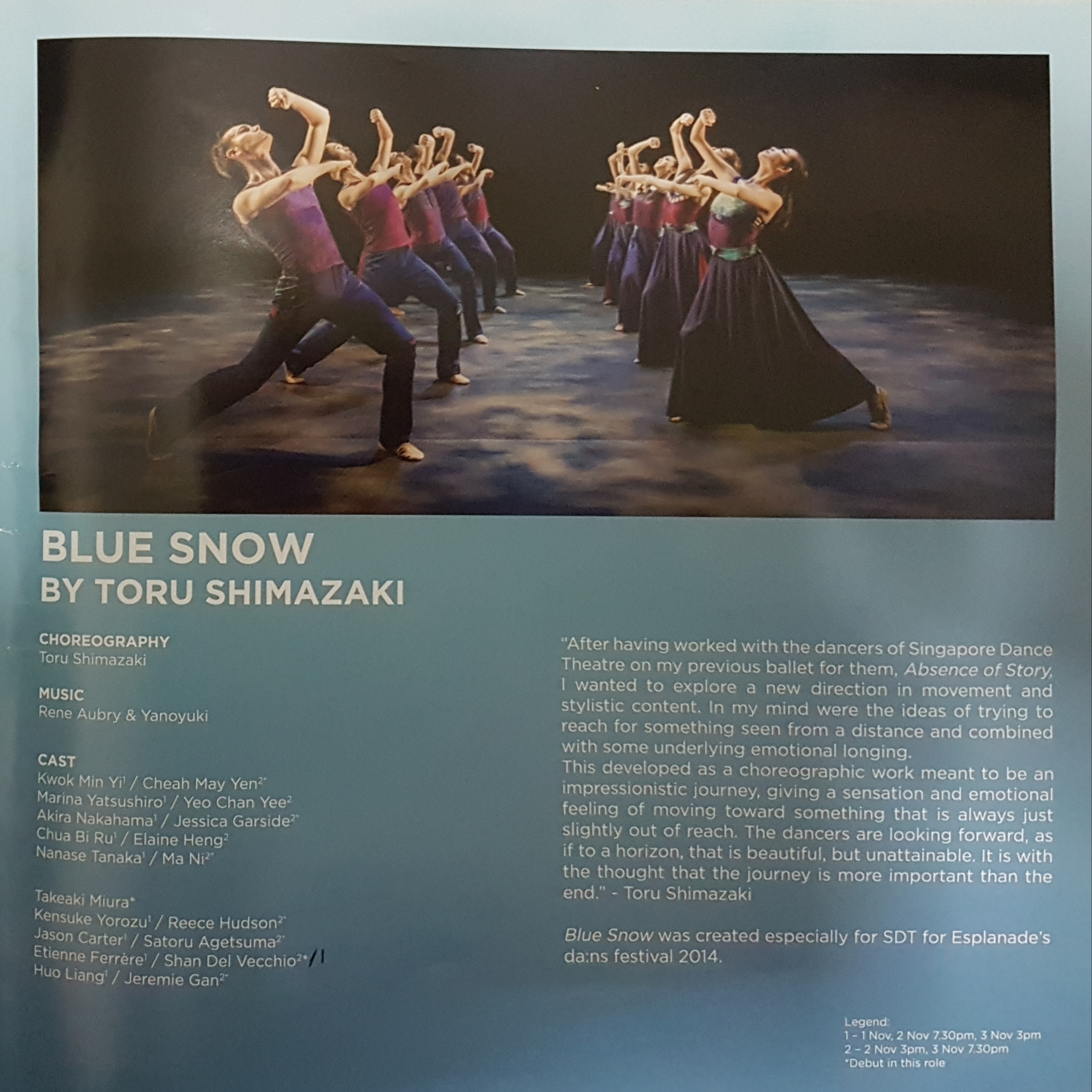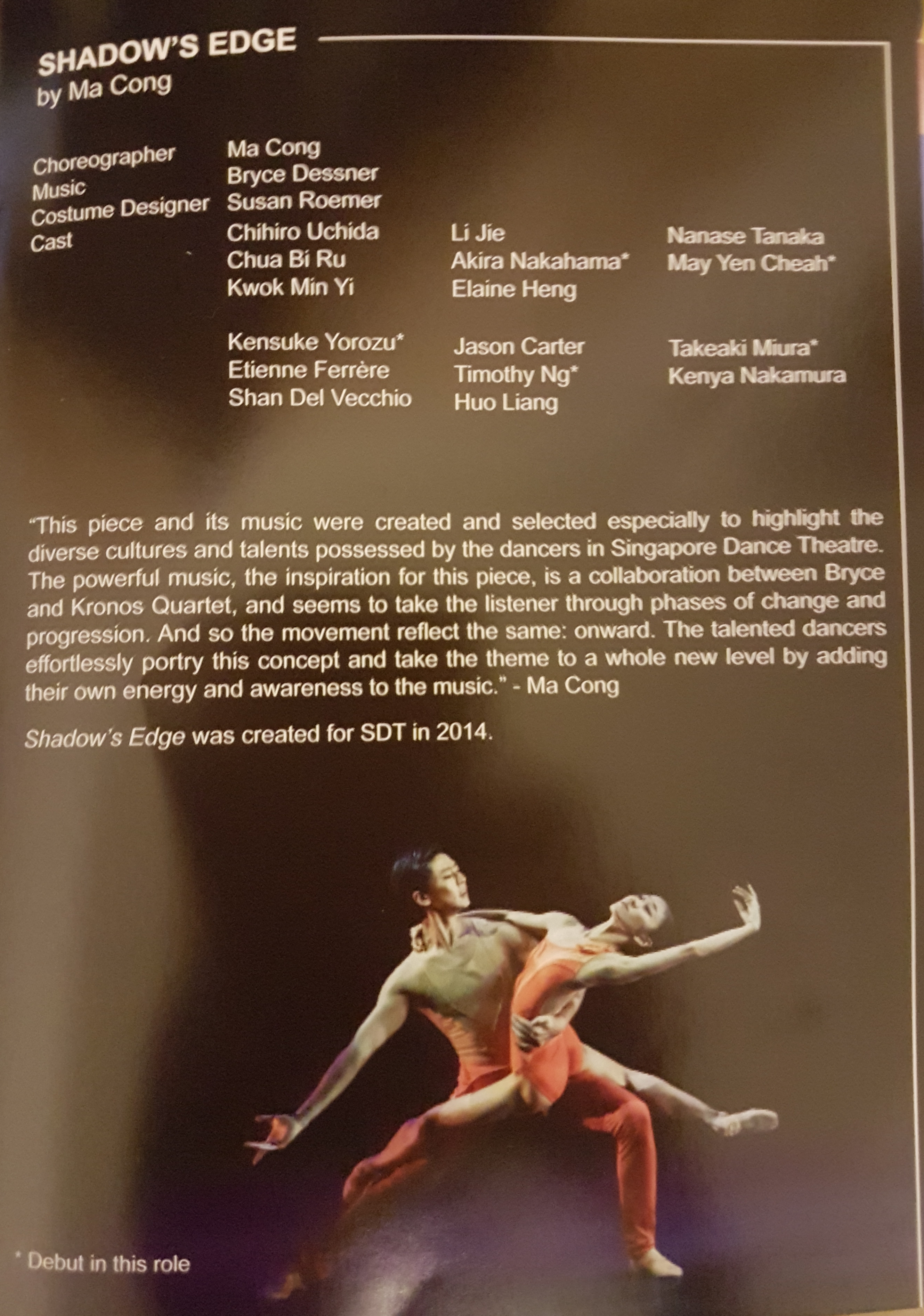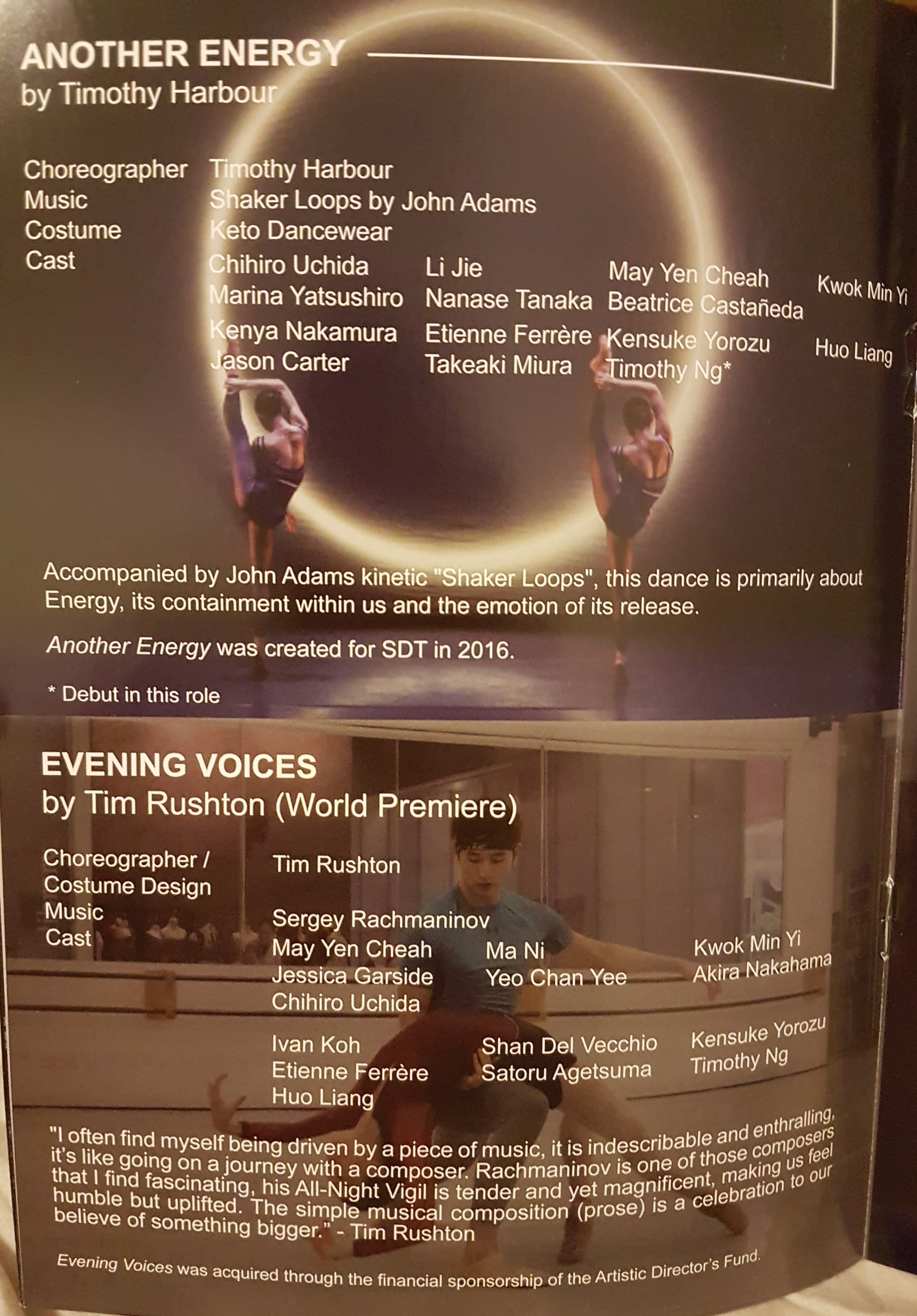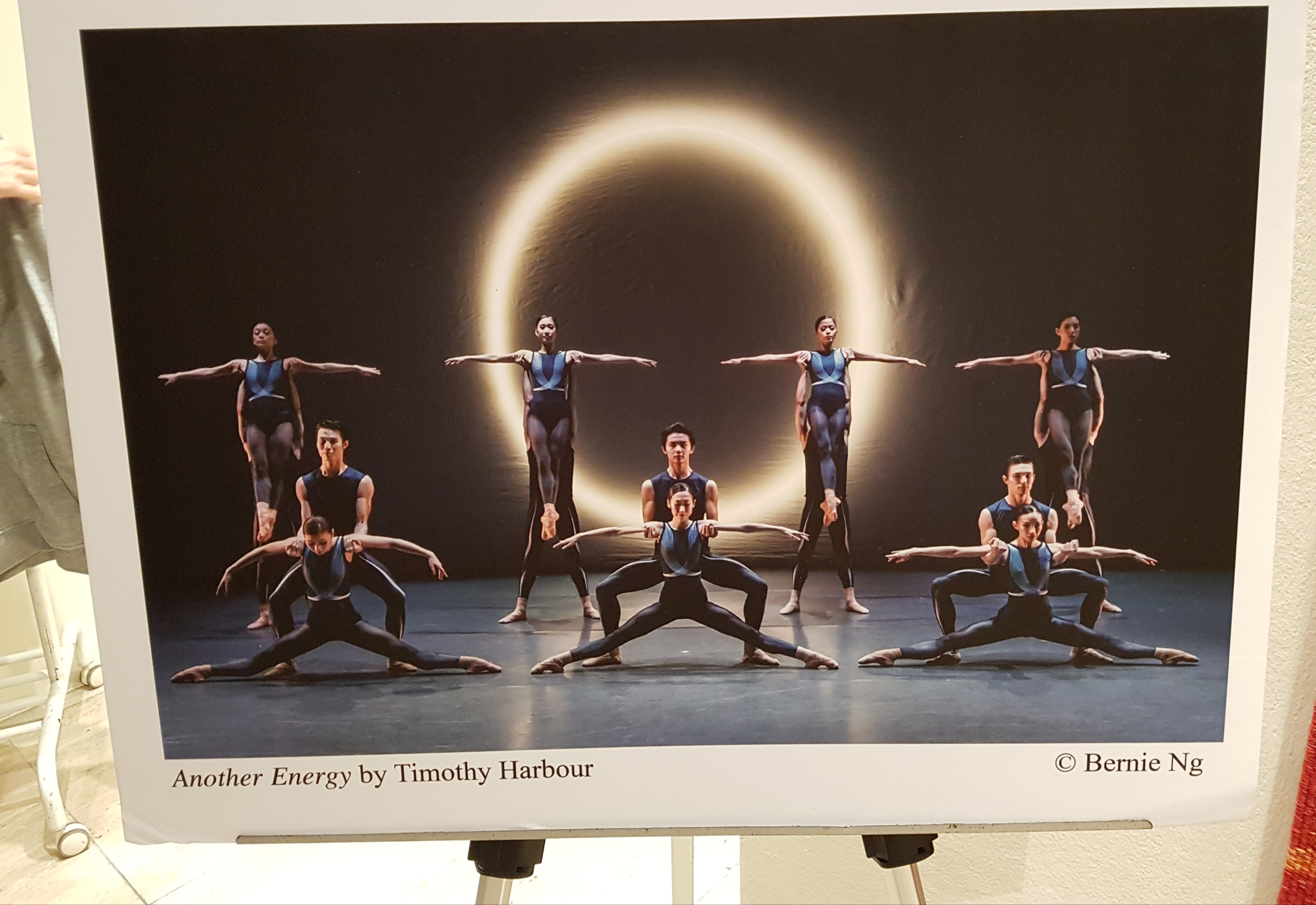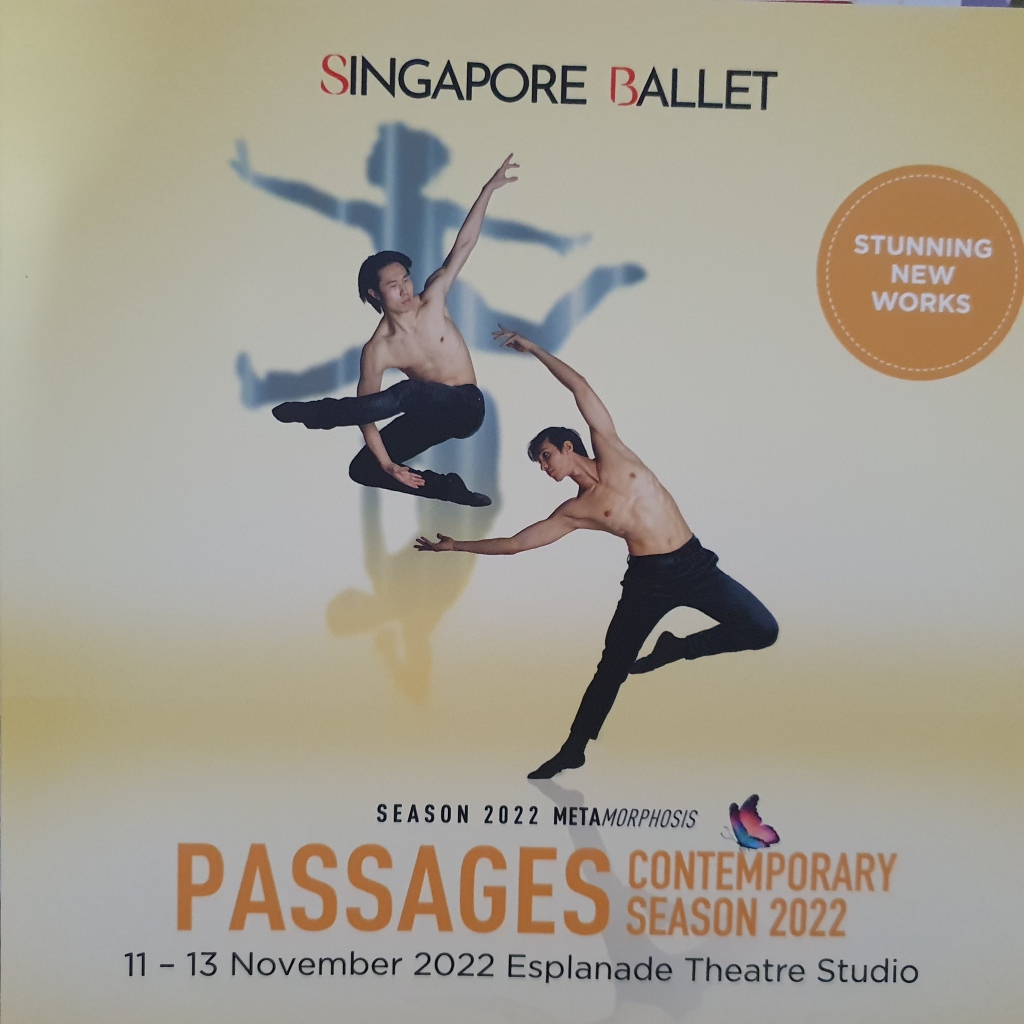
Pictured: Huo Liang and Shan Del Vecchio
1. Protecting Veil
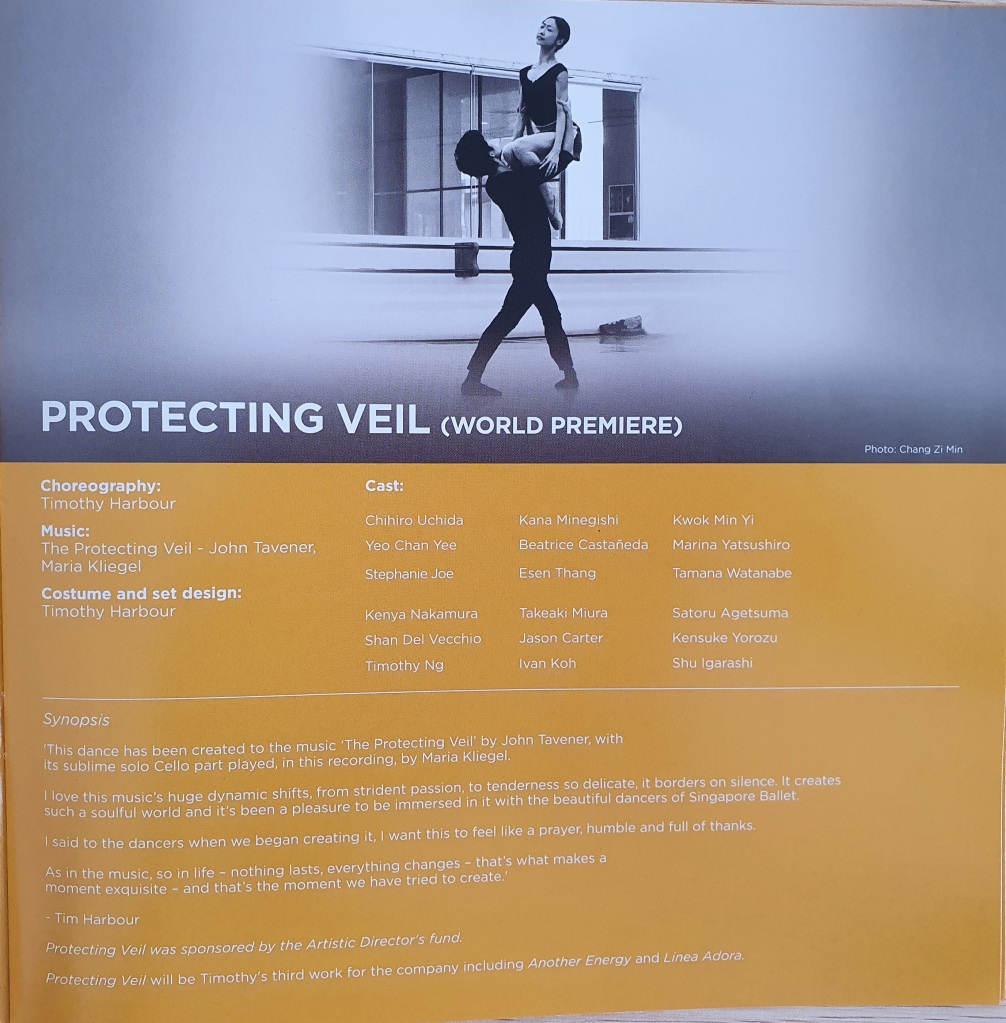
A backdrop lit orange by a row of little lights below, making the background look like the wall of a lantern.
A woman crosses the back of the stage from one side to the other with her back to us, arms raised, one hand clutching the other hand’s wrist, and as she bourres, bent sideways gently like a stalk in the wind, she pats the screen, making a sound like a veil flapping in the wind. After she exits, three couples enter, women in a sitting position and men holding them and dragging them backwards in a half-arc onto the stage, and back out again.
Because we are in a small theatre, we can hear Uchida Chihiro’s shoes tapping rapidly (fast, so fast) across the ground when she first enters with her arms raised in a V shape, as Nakamura Kenya enters the other side of the stage; Chihiro’s expression remains light, pleasant, serene in this pas de deux. There are little touches I like in each of the pas de deux in this piece: Chihiro and Kenya stepping forward and leaning forward curiously to look at us while we stare right back; Kenya and Chihiro standing next to each other and one after another, slowly letting a single-shoulder shrug roll down their body and consume their movement, Kenya shifting slightly behind Chihiro and sliding back out. Quite fond of the lifts in Protecting Veil, and there are so many – Chihiro lying sideways across Kenya’s shoulders; Chihiro catching Kenya’s hand between calves, a lift with clasped hands, Chihiro seated on Kenya’s arm; the breathtaking moment where she grasps his wrists and leaps up in a tuck-jump to rest lightly on his chest.
Kwok Min Yi and Agetsuma Satoru are the second main couple – he lays her on the ground and she curls up like a sad sunflower seed while he tries to comfort her. I like how their moves look, how she slides her hand behind her back to grasp his so that he can pull her into a lift, Min Yi’s hand gripping her thigh while Satoru lifts her over his shoulder in a split; how she lies sideways on his shoulder with legs in a cycling position that has an almost severe look to it. The mood of their pas de deux shifts like the sea washing up on the beach and out again: one moment a little spark of triumph in connecting hands, another moment disconsolate on the ground; the next, leaning forward in hope as if drawing curtains to the morning light.
The third pas de deux opens with a little more drama. The other dancers have gathered at a corner and when they move away from it, they bring with them Shan Del Vecchio, a long white veil trailing behind him, and Yeo Chan Yee in their midst, so that when the other dancers fade away and the veil is laid on the ground in a seashell shape, she may lie back in elegant repose in the dead centre of the stage with her back to us, staring at Shan as he stands at the tip of the seashell. Venuses rising from the Sea. It feels like a new world exploration for a wondering wandering couple (I liked the move where she turned her leg through full rotations in the air, and <edit, this is Minegishi Kana and Miura Takeaki in a soulful tender delicate pas de deux> another kind of playful moment where they were on the ground and it looked as if she were rolling him along under her legs as he rolled on the sand). Chan Yee has her own brief solo as well, through which you can feel the choreographer’s voice and intent – a resolute hand pushing down through the ground, the full articulation of the foot pushing off the ground and the sleek turns. This segment ends with the crab-claw lift, where Shan lifts her in the air and she opens her arms and legs to embrace the sky, and more couples enter, girls lifted in the crab-claw lift.
At some point in time, a veil is drawn on either side of the stage – and then fans turn on and the veils flutter out horizontal to the stage. I’m quite fascinated because we don’t often have props flowing out from the sides of the stage, or dancers interacting with props in the way they have here, touching the backdrop and so on. Two of the pas de deux are repeated with slight variations – Chihiro’s and Min Yi’s – this is welcome, and feels somehow comforting. There’s a repeat movement of Shan (? <edit: Miura Takeaki?>) and later, Watanabe Tamana drifting across the back of the stage in the opposite direction from before, patting the screen; and perhaps because of the shift in mood, the pattering sound sounds ominously like the wings of a moth against a lantern.
A word on the other dancers in the group: They are the community that makes up a protective veil (though also a community that wraps itself around Chihiro and sweeps her away backwards into the curtains away from Kenya). We’re pleased to see the various dancers, from familiar faces to the newer younger ones. A part that comes to mind is the moment where they are dancing and then Minegishi Kana leaps out of the corner to join the other dancers, and then as one they drift to the corner on their very highest pointes or demi-pointes and freeze for a moment in absolute silence, which keeps you guessing, and then they patter out again like rain drops, falling to the ground and swiveling double-speed on their stomachs on the ground, rolling up again. They are breathtakingly fast, and they fill the frame and the stage with their presence.
One of the parts we like best is when they stand in a square of three by three, and they lean outwards and lean back in like expanding constellations, while Beatrice Castañeda and Jason Carter dance in the foreground, deft and neat, precise, a moment of exploding joy, like a morning star. Beatrice stands out, bright and exuberant in this dance. In another part we like, the men, who are holding the ladies aloft, lay the women down in a ring around Satoru, and when the women draw in their arms and legs to curl up like seeds, the ring of bodies constricts around Satoru in a mesmerising pattern. Satoru has a short solo that is strongly executed as always; it was something we would like to see again.
At the end, the group dancers, the expanding constellations, stand in rows on the stage and Chihiro steps out with the white veil. The fans stop; the horizontal veils drop. The screen below unbuckles and drops so unexpectedly it could almost be an accident. For the first time the crowd of dancers sees Chihiro, or she sees them. And then as the lights dim so that faces are invisible, the group coalesces into a sculpted pile of bodies with their backs to us, an incredible massive structure of men bent over to create a small mountain, and ladies seated in the outer ring pressing their hands upwards against the men’s waists, their carved shapes gleaming under the lights.
Chihiro climbs up the mountain. At the top she sits, and the white veil in her open palms is drawn down away from us, sucked into the other side of the sculpture, until it is all gone. Chihiro sprawls upon the pinnacle of the structure of bodies and she turns to look at us with a serene and intelligent, piercing look. What an indescribable feeling! It is an artwork, a work of absolute art…
And then Chihiro slides over the bodies and sinks head-first down into the other side of the sculpture as the lights go off.
Wow.
Lifts lifts lifts. I liked them. See above as well.
There are no photographs because the theatre was quite small and I felt a little shy about taking photos. The ladies wore vanilla yellow and the gentlemen wore orange trousers, as seen above.
2. Bittersweet

We reviewed this before, the Min Yi and Jason Carter version, in 2019.
It opens with Min Yi draped like a cross over Jason’s back, sliding her feet up and down her legs as if feeling her feet for the first time. She peels herself away from him and flits away across the stage, stopping in a brittle arabesque, buckling to the ground. She has discovered herself and come to life; and it takes a while for Jason Carter’s character to respond and to see her. And when he does, first she tries to return to him, curling onto his back and unfurling away.
They dance with such strength and calm. Min Yi’s dancing is graceful and every gesture of her limbs is expressive and meaningful; through them flows an emotion that stretches beyond the fingertips. The arms beseech, they caress. Jason, with his lyrical grace, exudes tenderness and care in every movement and perhaps for the first time we see that when he swings her down from one of the lifts, he must cradle her neck carefully. Patiently, Min Yi loops an arm around him and waits, and he will swing her like a diamond trapezoid over his shoulders, lift her as she lies like a swallow across his shoulder – somehow this image is not one of flight and hope, but of a yearning for freedom. Very gently, while her arm is draped across his shoulder blades, he carries her so that she appears to barely rest any weight on the ground as she steps, and steps, across the water.
At the very height of emotion, he lifts her up so she rests her palm on his shoulder and he carries her with one hand up, and travels across the stage. Where once it was a single-hand lift with the gentleman standing still, somehow this fits their version – as they travel, so too does the music swell and we are swept away.
Yet the performance does not feel heavy. You must know also that the dance is not choreographed as one long emotional handkerchief of tears. There are moments where there is a mellowing, and a gentle slowing of momentum – where he pulls her wrist delicately while she leaps lightly at him and he catches her, tilting her at an angle so her hand almost touches the ground. Weightless moments; seated on the ground, she folds her hands over her ankles, which move conceals her face and emotions, while he bows over the arch of her back; where she clings to him and he lifts his leg in successive motions as if to toss her upwards and away, but they move gently. Soft moments, soft emotions.
Perhaps their ties can be sundered – witness the scene where a white light lies diagonal like a sword blade across the stage and he is drawn towards it and though he tears himself away each time, he is pulled further and further away from her while she waits in agony for him. Yet in the end he chooses to return, and she wraps her hands to his face and clings to him as he steps backwards and drags her, not into the future, but back to their shared past. And so he chooses to accept her, even if he cannot see her face again or dance with her; and he willingly allows her to reluctantly slip her arms over his shoulders and drape herself over his back again.
Beautiful. We do have photographs for this (Saturday matinee). (We did feel our eyes fill. It had nothing to do with a story we made up along the way and above, which we just entertained in brief flashes – mermaid who finds her feet. Simply the entire mood created by this work and the dancers and the music, working to create the whole….)
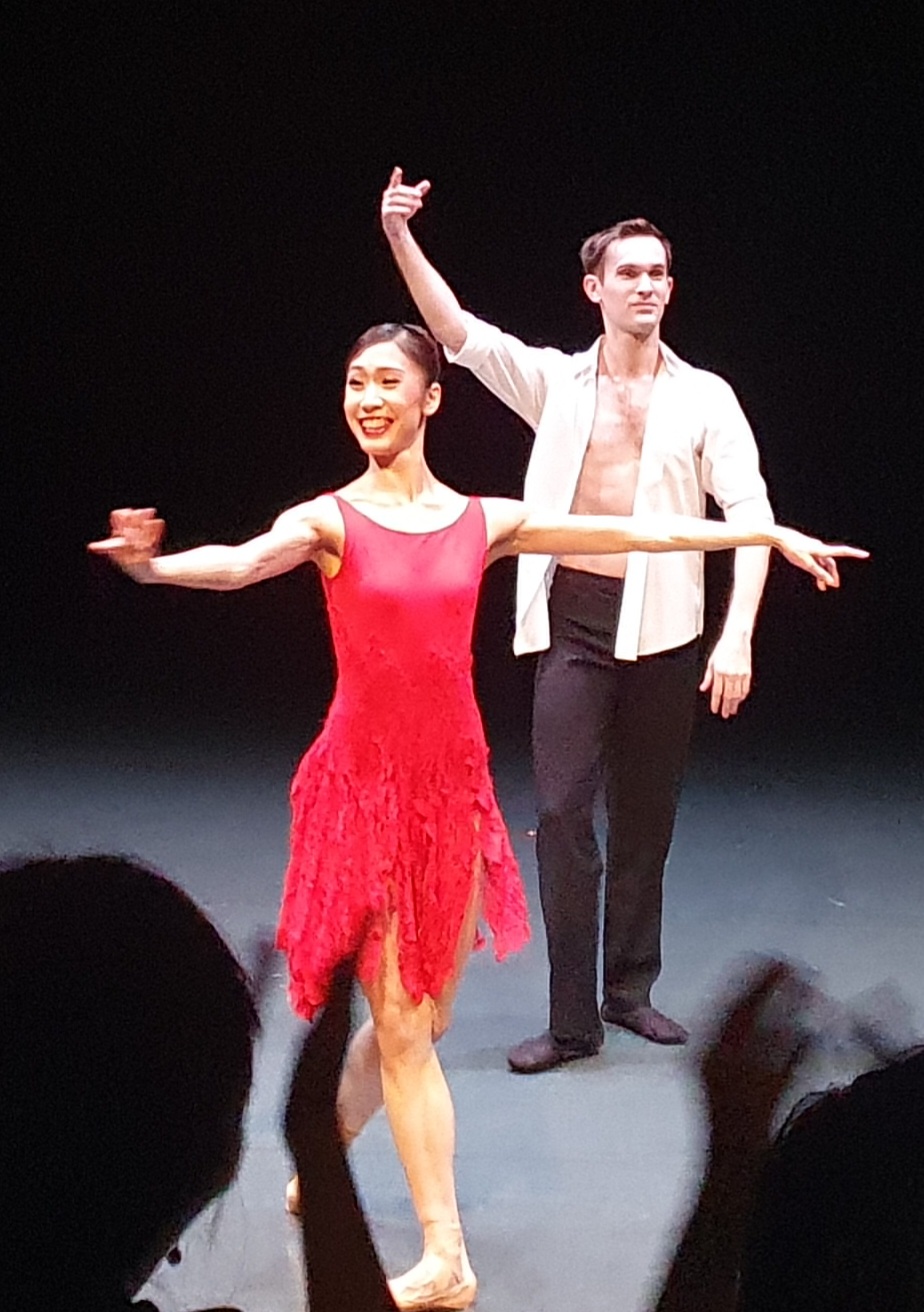
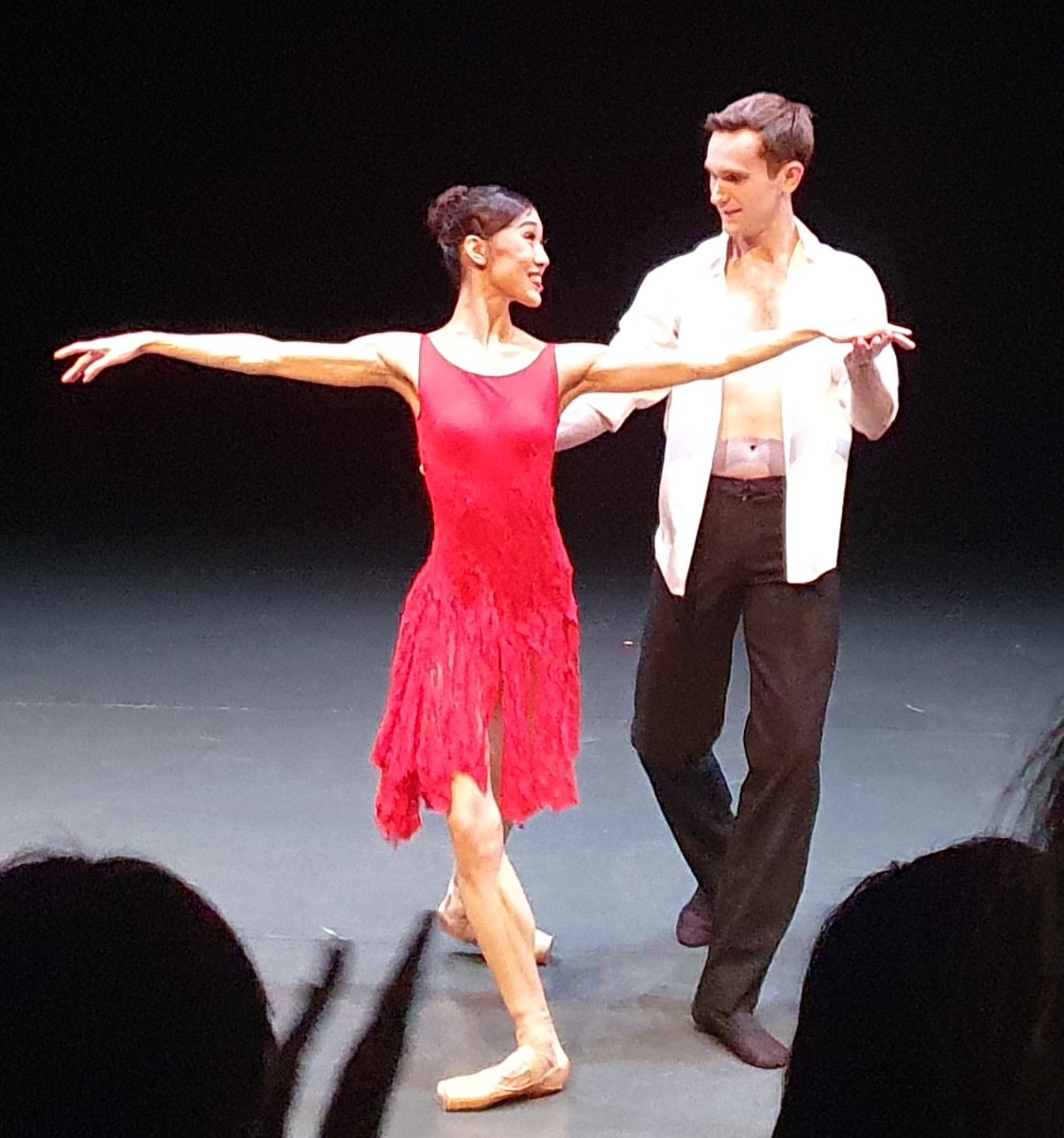

Have some gorgeous photos, please.
3. The Sound was our Ocean
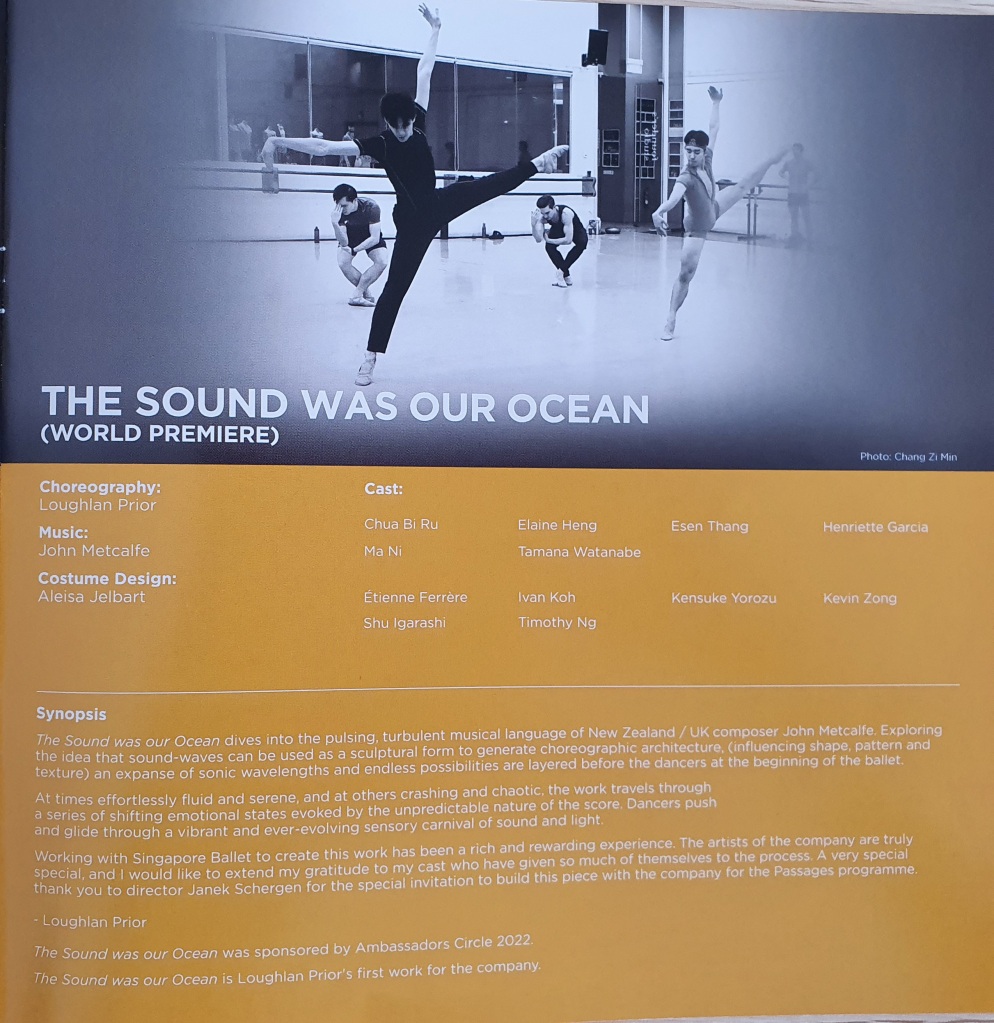
Above: Foreground – Ivan Koh, Igarashi Shu; background – Kevin Zong, Étienne Ferrère
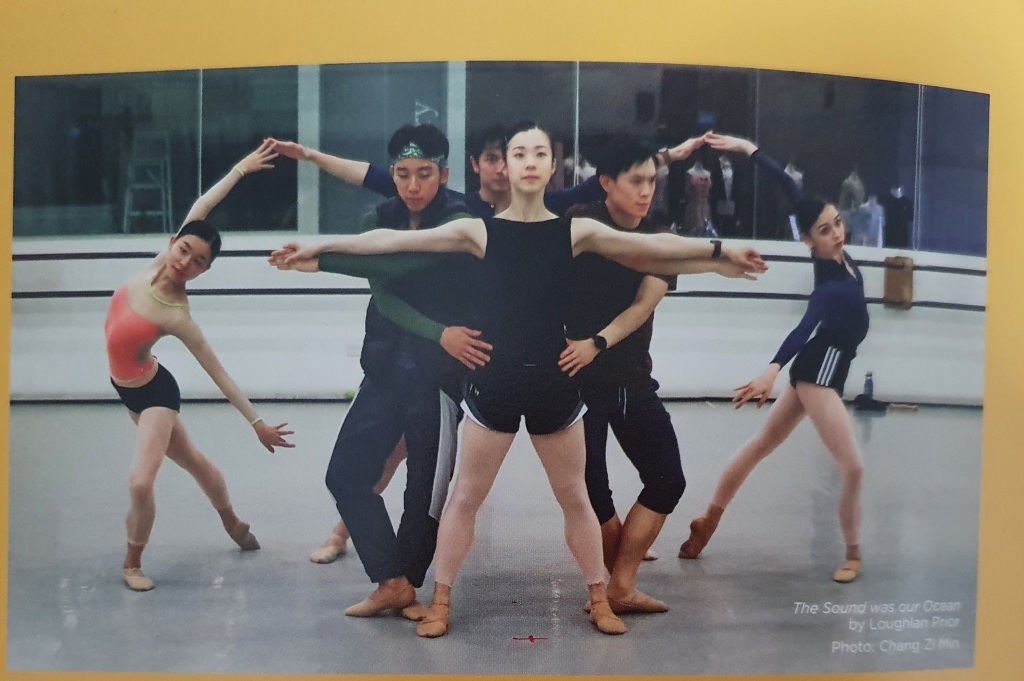
L-R: Watanabe Tamana, Igarashi Shu, Timothy Ng, Chua Bi Ru (foreground), Kevin Zong, Esen Thang
Let’s hear from the choreographer himself!
When this begins, we see only the silhouettes of the dancers moving rhythmically. In the dimness we first make out a dancer in the front row (Esen Thang) who has a marked fluidity and expressiveness to her dancing. When the lights go on, we see the dancers are wearing the most solid blue colour possible, blue as the dream ocean, and bopping to the electronic synth pop music in the video above, repeated in Act 3. They are the happy oysters of the ocean – fast legs opening into triangular shapes, arms swinging up and down like pipes behind backs or like pendulums up and around their heads, catching hands and pulling back so fast you think they’ll almost spin like spanners. If you look at the IG post above, this is a snippet similar to the first Act (reminds us of the third, though) – joyous celebrations by the sides while central works in the middle burst into fireworks.
And so much of the work feels like a celebration. I like the speedy fiery group dances scattered through the piece: arms swinging back so fast hands almost punch shoulders, sweeping arabesques spitting backwards, men swinging ladies near-horizontal to the ground with their legs forked, the high lifts where the girls swing into crescent shapes, the exuberant Christmas tree lifts you see in the video above where the ladies are as high as pendants on trees.
Lots of moments pop and sparkle for us. The duo dance by Igarashi Shu and Kevin Zong: energetic and controlled flair, their limbs a blur in the misty lighting. The pas de deux, one after another, layers upon layers: Ma Ni and Kevin Zong’s pas de deux flows fast and easy on the eye – there is always a fine grace in Ma Ni’s dancing that makes it look beautiful and interesting; a delightful pas de deux from Ivan Koh and Henriette Garcia, who both bring out the contemporary spirit in the music, Henriette with a feline grace and confidence seen also in her swift and fun dance with Étienne Ferrère in the almost-final Act; Elaine Heng and Etienne in a marvellous smooth pas de deux like pulled taffy, or molten marshmallows, lines pulling and energy flowing through their moves; Ma Ni and Jason Carter moving easily in part of a group dance, lending the dance a sense of camaraderie; dancers bursting out from the centre and racing round the stage playfully as if at a playground.
This is a robust work of love.
A good chunk of the heart of this piece goes to the two rounds of pas de deux with Shu and Watanabe Tamana. The cookie in the ice cream. A riveting pas de deux with two dancers who have bold, vigorous, exciting styles that meld well when put together. Shu dances with imagination and a little dramatic flair as well; a flick of the arm wraps one in an invisible cloak. Tamana dances with skydiving confidence, unafraid: the body is thrown fully into a leap into the air; she leaps up fearlessly to balance on his shoulder, her feet crossed at the ankles and pointing down; the leg is thrust fully squarely to the side. One cannot be afraid to do the moves that may make one look ugly (but actually don’t). And at the same time both dancers participate in full so the dancing sparkles: the dream-catcher and the sunlight, the lollipop and the ferris wheel. They balance each other out securely and they make the rigorous pas de deux easy to watch.
Chua Bi Ru has a solo in the middle of this dance, a solitary body of loneliness in every twist of the torso and the limb, in a hand reaching back to grasp a raised ankle, in slowly running around the stage and coming up against the half-circle of turned backs. A thought crosses the mind that she is and will be the OG… wringing expression from every ounce and nerve fibre of the being. In that final moment when she is sprawled back on the ground staring at us upside-down with an almost Exorcist-like effect, something resonates within the desolate heart.
Timothy Ng, Yorozu Kensuke and Esen Thang hold another jigsaw piece in a little trio dance, Esen a flag twisting in the wind between the two. They all make it look far easier than it really is; the gentlemen roll and slide into place in lifting her, turning Esen; Kensuke and Esen in a kind of waltz while Timothy draws strong shapes in the air. Seamless and slick. It’s interesting how Esen’s voice shows in this. In an earlier scene <edit: in the orange Protecting Veil, not this dance> when the ladies all lean forward and push their faces between their parallel hands as if looking through a box, there’s a sense of liquid plastic in Esen’s movements, a kind of contemporary dance voice, and funnily, we can almost see the actual box.
It’s when the men burst out onto the stage in a rollicking display – Shu and Ivan, Etienne and Kevin, then Kensuke entering to dance in sync with Shu and Ivan <edit: Then Timothy enters behind as well> – boundless energy, charisma and polished moves, one of the most thrilling and memorable moments – that we look again at the cast list. Every single one of the dancers has their own distinct characteristic voice. We watched the opening carefully the second time round and looked at all the dancers in the dimness. You could not see their faces but they were all moving in their own way and yet perfectly together.
This ends with Tamana and Shu in a very brief dance together, and at last she heads off into the distance while he follows her with a listening expression; and he scoops her into his arms and she draws up her arms and legs as if she’s running, all limbs in right-angles. Then lights out. You won’t doubt that this is the ending.
We’ve seen the running pose before in other things – Organ Concerto, I think. I feel like it’s also in Lambarena but probably not. This one is not dead centre (unlike Organ) — it’s to one side. It doesn’t feel sinister. It feels complete.
What’s there not to love! I’d like to see it all over again.
4. Faux Contact
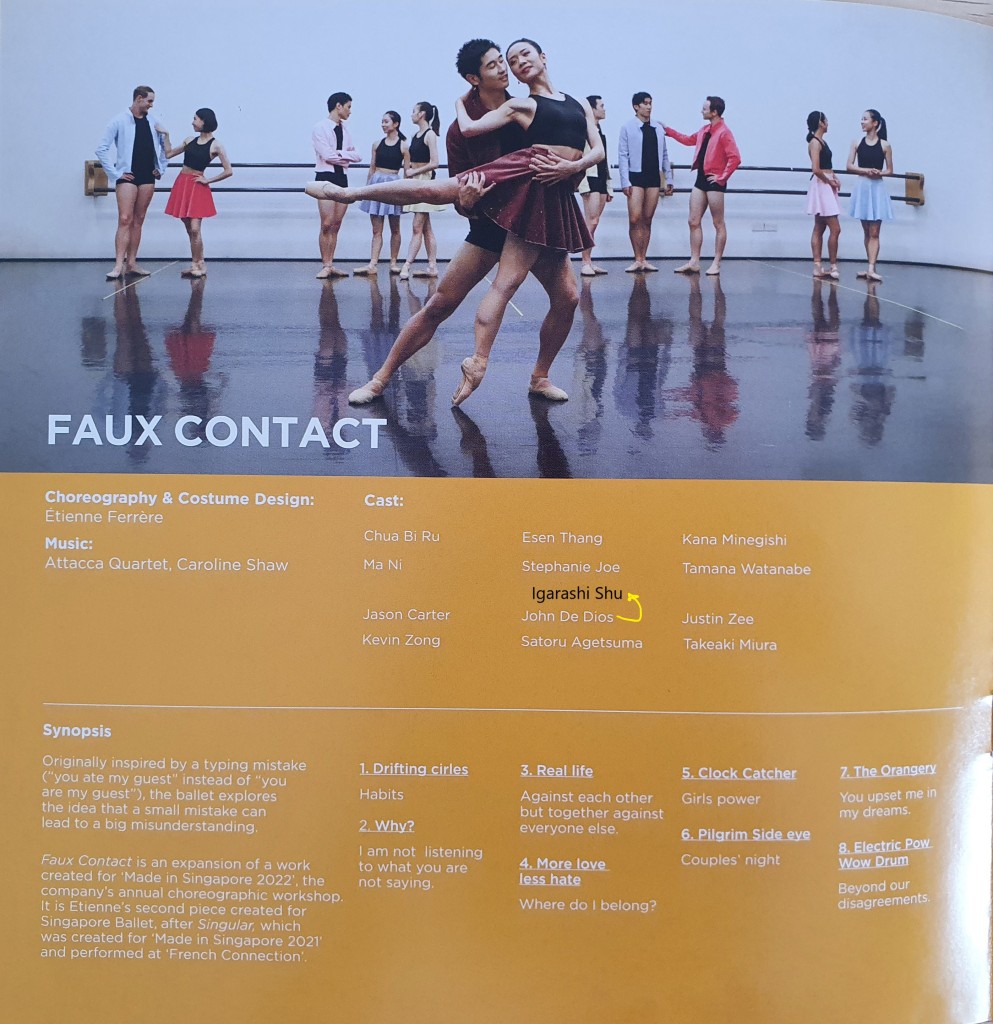
We’ll have fun, fun, fun till her daddy takes the T-bird away.
This was “You Ate My Guest” choregraphed by Etienne from earlier this year, but updated. Back in the day (some months back), the Artistic Director Mr Janek Schergen had said that he told Etienne that it needed one more scene to make it complete, and here we are.
This begins with the dancers in two groups, the inner core and the outer ring, leaning out and back in like atoms. This segues quickly into the effervescent showstopper we know and love: the mincing ladies, the strutting dancers, Stephanie Joe’s expansive bold dancing as Queen Bee with Agetsuma Satoru as her un/willing companion, the line up as if for Mr Universe/ Miss Universe (which brings little snickers from the audience), the signature move of a hand sliding down the chest to the waist and the arm opening out in an arc; the two lines of dancers facing off on opposite sides of the stage as their misunderstandings spill across a dark void in the middle; the men in a funny little mime round the ladies, picking up phones and sending emails with a quirky quizzical air. They know they’re in on a joke and that’s half the fun.
We do have more quiet moments in the dance. Kevin Zong takes on Jasper Arran’s solo – after a wild night dancing, the boys exit and one of them chucks him briefly under the chin. The music after is so quiet it’s almost silent. Kevin is still slightly giddy with the echo of the last dance in his mind, fingers pointing in the air…but this moment turns inwards into self-questioning and tear trails, into the eternal internal questions. One can of course waltz with classical grace – take my hand – but there remains an inner turmoil to be resolved when we jive to another beat. Kevin’s version is quiet, introspective, and sincere, so nothing in it is tacky – not the tear trails, not the inner pondering. The solo is difficult because it looks into the mind and heart, and it has passed into safe hands.
Where once this moved into a pas de deux, we instead see the men entering swatting away the mist as if they are batting away flies, and then two sets of group dances with the couples: pastel candy-clothed couples in elastic springs-in-their-heels hops and jumps, women in uber-fast lifted spins and jumps, and wine-berry couples in a soulful mood, gentler and calmer. If you look closely at the pas de deux following this, you can see a move that is similar to something Kevin has danced before them, because his solo once immediately preceded it. It’s like sliding a new panel between pieces.
And so we now go into the terrific pas de deux between Minegishi Kana and Miura Takeaki. Kana is a spitfire, emotionally unstable, stumbling in her arabesques into Takeaki’s arms – a deliberate stumble in each show that makes you catch your breath. Fast and furious with her emotions, exquisite in her agony. He is her bedrock and stable pillar, catching her in at the height of her fury, clasping her face in his hands – look at me, he says, and he is the linchpin, the centre of her wildly-spinning compass. In his arms, paradoxical as it may sound, she flies, she soars freely, and their duet is wrenching, head-spinning, jaw-dropping. There are heights they reach when dancing together that are achievable because they are dancing together.
The final Act(s) that follow are simply sheer joy and the dancers exude an infectious genuine enjoyment. Boom, the lights go red and and the male dancers strike poses, swing their arms like they’re turning giant invisible steering wheels; the dancers spill out onto the stage for a final showdown swinging their arms back as if they’re falling over, pumping their arms back as if they’re pressing on giant horns – hold back, hold back, here we go, here we go; bopping to music as they stride to the back and freezing in profile to face the flashlights blasting in their faces left and right, like celebrities. Tamana in a corner winding up her arm to spin an invisible bowling ball at the dancers; dancers holding invisible golfing clubs or rat-a-tat-tatting on drums, high energy power drinks and cool kids on the block. This is the music and dancing we will always want to remember.
For a little moment when the music in the final Act played, I was hit with a wave of inexplicable nostalgia so great I almost teared up.
We note John De Dios was in the cast list but was unable to be in this; we would have liked to see him in this as he has so much to add (great form, a quirky humour within, seen in some pieces). Igarashi Shu danced in his stead and did a great job, bopping along to the beat and his own internal drum, conveying the mirth in the music. We need to add a word in also– pleased to see that Jessica Garside was the ballet mistress for this 🙂
(One more word: you ate my guest? but i loved your dinner party
Oops i meant to put a comma, not a question mark. Same thing…?)
*
You would have loved “You Ate My Guest”, I told a friend after Made in Singapore 2022, you should have seen all the dances but you would have loved it. And so when I saw this on the line-up, I bought her a ticket and she enjoyed the entire show but of course it ended on an absolute raving high note for her with Faux Contact. I didn’t think I would invite people who rarely watch SB to watch any longer, and anyway we are introverts. But bring your friend if Faux Contact is on the list. I can’t think of anyone who will not enjoy it or who will (shh!) fall asleep.
*
wow, we made it to the end of this on the promise of genshin, which I haven’t played for over 2 weeks, but we’ll see how it goes.
